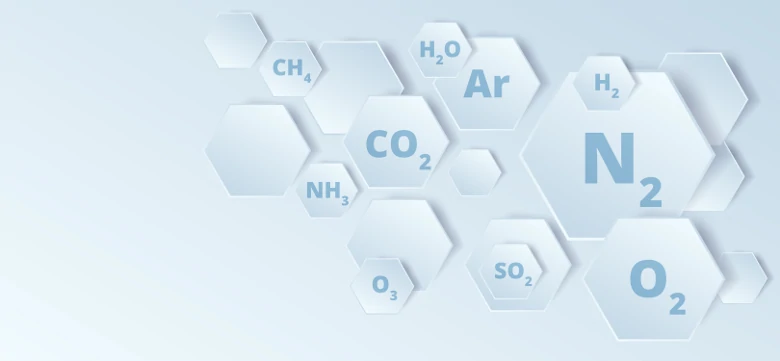Writing Chemical Equations
This article is going to cover the topic of Writing Chemical Equations along with the following learning outcomes:
- Interpretation of chemical equations with state symbols
- Writing balanced chemical equations with state symbols
- Writing ionic equations with state symbols
This article is written to meet the requirements of Singapore's Upper Secondary Chemistry syllabus.
Whats is Chemical Equations?
A chemical equation shows what happens in a chemical reaction.
It tells us:
- which reactants and products are involved in the reaction;
- the relative amounts of reactants and products; and
- the physical states of the reactants and products of the reaction.
We can write an equation by using words or chemical formulae.
Take a look at the following reaction between hydrogen and oxygen to form water.
Word Equation
\(\small{\mathsf{hydrogen + oxygen \quad\xrightarrow[\quad\quad]{} \quad water}}\)
Chemical Equation
\(\small{\mathsf{2H_2 + O_2 \quad\xrightarrow[\quad\quad]{} \quad 2H_2O}}\)
- The reactants are always written on the left-hand side of the equation. In the above reaction, hydrogen and oxygen are reactants.
- The arrow means that reactants react to form the product. The reaction proceeds from left to right.
- The product is always written on the right-hand side of the equation. Water is the product in this reaction.
- Coefficients are placed in front of the chemical formulae of the reactants and products to balance the chemical equation. So the balanced equation reads two molecules of hydrogen gas react with one molecule of oxygen gas to form two molecules of water.
Balancing Chemical Equations
What is a balanced chemical equation?
A balanced chemical equation must contain equal numbers of atoms of each element on both sides of the equation.
Steps involved in Balancing Chemical Equations
Sodium reacts with chlorine gas to form sodium chloride.
Step 1: Write down the chemical formulae of the reactants and products.
\(\small{\mathsf{Na + Cl_2 \quad\xrightarrow[\quad\quad]{} \quad NaCl}}\)
Step 2: Check the number of atoms of each element in the formulae on both sides of the equation.
- On the left-hand side of the equation, there are \(2\) chlorine (\(\text{Cl}\)) atoms.
- On the right-hand side of the equation, there is only \(1\) chlorine (\(\text{Cl}\)) atom.
- Hence, the equation is not balanced.
Step 3: Balance the equation.
- To balance the number of chlorine atoms, we need to put a coefficient ‘\(2\)’ in front of \(\text{NaCl}\) on the right-hand side of the equation.
- This results in \(\text{2 Na}\) atoms on the right-hand side, but only \(\text{1 Na}\) atom on the left-hand side.
- To balance the number of sodium atoms, we need to put a coefficient ‘\(2\)’ in front of \(\text{Na}\) on the left-hand side of the equation.
\(\small{\mathsf{2Na + Cl_2 \quad\xrightarrow[\quad\quad]{} \quad 2NaCl}}\)
Step 4: Add the state symbols to indicate the physical state of each reactant and product.
- \(\text{(s)}\) represents a solid state
- \(\text{(l)}\) represents a liquid state
- \(\text{(g)}\) represents a gaseous state
- \(\text{(aq)}\) represents an aqueous state/solution i.e. dissolved in water
\(\small{\mathsf{2Na\,(s) + Cl_2\,(g) \quad\xrightarrow[\quad\quad]{} \quad 2NaCl\,(s)}}\)
Example 1:
Balance the following chemical equation.
\(\small{\mathsf{CuO + NH_3 \quad\xrightarrow[\quad\quad]{} \quad Cu + H_2O + N_2}}\)
Solution:
Check the number of atoms of each element on both sides of the equation.
\(\small{\mathsf{\underline{ \text{LHS RHS}}\\[2ex] \text{1 Cu 1 Cu}\\[2ex] \text{1 O 1 O}\\[2ex] \text{1 N 2 N}\\[2ex] \text{3 H 2 H}}}\)
There are \(\text{2 N}\) atoms on the right-hand side of the equation but only \(\text{1 N}\) atom on the left-hand side of the equation. To balance the number of nitrogen atoms, we need to put a coefficient ‘\(2\)’ in front of \(\mathrm{NH_3}\) on the left-hand side of the equation.
This results in \(\text{6 H}\) atoms on the left-hand side of the equation but only \(\text{2 H}\) atoms on the right-hand side of the equation. To balance the number of hydrogen atoms, we need to put a coefficient ‘\(3\)’ in front of \(\mathrm{H_2O}\) on the right-hand side of the equation.
This causes the number of \(\text{O}\) atoms on the right-hand side of the equation to be \(3\), but there is only \(\text{1 O}\) atom on the left-hand side. To balance the number of oxygen atoms, we need to put a coefficient ‘\(3\)’ in front of \(\text{CuO}\) on the left-hand side.
Finally, there are \(\text{3 Cu}\) atoms on the left-hand side of the equation, but only \(\text{1 Cu}\) atom on the right-hand side. To balance the number of copper atoms, we need to put a coefficient ‘\(3\)’ in front of \(\text{Cu}\) on the right-hand side.
Hence, the final balanced equation is:
\(\small{\mathsf{3CuO + 2NH_3 \quad\xrightarrow[\quad\quad]{} \quad 3Cu + 3H_2O + N_2}}\)
Question 1:
Which of the following correctly shows the values of \(\color{red}{\textbf{a,}}\color{blue}{\textbf{ b}}\) and \(\color{green}{\textbf{c}}\) for the reaction below?
\(\small{\mathsf{PCl_5\,(s) + \color{red}{\textbf{a}}H_2O\,(l) \quad\xrightarrow[\quad\quad]{} \quad \color{blue}{\textbf{b}}H_3PO_4\,(aq) + \color{green}{\textbf{c}}HCl\,(aq)}}\)
\(\small{\textbf{a b c}}\)
- \(\small{\textsf{2 1 4}}\)
- \(\small{\textsf{2 2 5}}\)
- \(\small{\textsf{4 2 4}}\)
- \(\small{\textsf{4 1 5}}\)
Solution:
(D)
Explanation:
Check the number of atoms of each element on both sides of the equation.
\(\small{\mathsf{\underline{ \text{LHS RHS}}\\[2ex] \text{1 P 1 P}\\[2ex] \text{5 Cl 1 Cl}\\[2ex] \text{2 H 4 H}\\[2ex] \text{1 O 4 O}}}\)
We can start by balancing the number of chlorine atoms on both sides of the equation. There are \(\text{5 Cl}\) atoms on the left-hand side but only \(\text{1 Cl}\) atom on the right-hand side. Hence, we need to put a coefficient ‘\(5\)’ in front of \(\mathrm{HCl}\) on the right-hand side. Thus, \(\text{c = 5}\).
This causes the number of hydrogen atoms on the right-hand side to be \(8\) but there are only \(\text{2}\) hydrogen atoms on the left-hand side. To balance the number of hydrogen atoms, we need to put a coefficient ‘\(4\)’ in front of \(\mathrm{H_2O}\) on the left-hand side. Thus, \(\text{a = 4}\).
Finally, there are \(4\) oxygen atoms on the left-hand side as well as on the right-hand side of the equation. Thus, \(\text{b = 1}\).
Question 2:
Which of the following sets correctly balanced the following chemical equation?
\(\small{\mathsf{Al_2O_3 + \color{red}{\textbf{x}}HCl \quad\xrightarrow[\quad\quad]{} \quad \color{blue}{\textbf{y}}AlCl_3 + \color{green}{\textbf{z}}H_2O}}\)
\(\small{\textsf{x y z}}\)
- \(\small{\textsf{3 1 3}}\)
- \(\small{\textsf{6 1 6}}\)
- \(\small{\textsf{6 2 3}}\)
- \(\small{\textsf{12 4 6}}\)
Solution:
(C)
Explanation:
Check the number of atoms of each element on both sides of the equation.
\(\small\mathsf{\underline{ \text{LHS RHS}}\\[2ex] \text{2 Al 1 Al}\\[2ex] \text{3 O 1 O}\\[2ex] \text{1 H 2 H}\\[2ex] \text{1 Cl 3 Cl}}\)
We can start by balancing the number of aluminium atoms on both sides of the equation. There are \(\text{2 Al}\) atoms on the left-hand side but only \(\text{1 Al}\) atom on the right-hand side. Hence, we need to put a coefficient ‘\(2\)’ in front of \(\mathrm{AlCl_3}\) on the right-hand side. Thus, \(\text{y = 2}\).
This causes the number of chlorine atoms on the right-hand side to be \(6\) but there is only \(1\) chlorine atom on the left-hand side. To balance the number of chlorine atoms, we need to put a coefficient ‘\(6\)’ in front of \(\mathrm{HCl}\) on the left-hand side. Thus, \(\text{x = 6}\).
Finally, there are \(6\) hydrogen atoms on the left-hand side but only \(2\) hydrogen atoms on the right-hand side of the equation. To balance the number of hydrogen atoms, we need to put a coefficient ‘\(3\)’ in front of \(\mathrm{H_2O}\). Thus, \(\text{z = 3}\).
Ionic Equations
What is an ionic equation?
An ionic equation is a simplified chemical equation that shows the reactions involving ions in an aqueous solution.
This equation focuses only on the species, which can be either an atom or an ion, that change their state before and after the reaction. For those species that do not experience any change before or after the reaction, we remove them from the equation.
Steps Involved in Writing Ionic Equations
Aqueous sodium sulfate reacts with barium nitrate solution to form solid barium sulfate and aqueous sodium nitrate.
Step 1: Write the balanced chemical equation, including the state symbols, for the reaction.
\(\small{\mathsf{Na_2SO_4 (aq) + Ba(Na_3)_2(aq)}}\) \(\small{\xrightarrow[\quad]{}}\) \(\small{\mathsf{BaSO_4(s) + 2NaNO_3(aq)}}\)
Step 2: Rewrite the equation in terms of ions for substances in aqueous state.
Sodium sulfate, barium nitrate, and sodium nitrate are soluble in water. They exist as ions in solution. When we rewrite the chemical equation in terms of ions, we get
\(\small{\mathsf{2Na^+ (aq) + SO_4^{2-} (aq) + Ba^{2+}(aq) + 2NO_3^{-} (aq)}}\) \(\small{\xrightarrow[\quad]{}}\) \(\small{\mathsf{BaSO_4(s) + 2Na^{+}(aq) +2NO_3^{-}(aq)}}\)
- Note that insoluble solids, covalent liquids and gases do not form ions in water. Hence, we do not break them into ions when writing an ionic equation.
Step 3: Cancel out the spectator ions.
Spectator ions are ions that have not taken part in any chemical reaction. They have not changed their states before and after the reaction.
- \(\mathsf{Na^+\,(aq)}\) and \(\mathsf{NO_3^− \,(aq)}\) ions have not changed their states during the reaction. They are still ions in solution at the end of the reaction. Hence, \(\mathsf{Na^+\,(aq)}\) and \(\mathsf{NO_3^− \,(aq)}\) are spectator ions, and they will be left out of the equation.
Step 4: Write the ionic equation.
Therefore, the final ionic equation is:
\(\small{\mathsf{Ba^{2+}\, (aq) + SO_{4}^{2-}\, (aq) \quad\xrightarrow[\quad\quad]{} \quad BaSO_{4}\,(s)}}\)
Example 2:
Write the ionic equation for the reaction below.
\(\small{\mathsf{Zn \,(s) + CuSO_4 \,(aq) \quad\xrightarrow[\quad\quad]{} \quad ZnSO_4\,(aq) + Cu\,(s)}}\)
Solution:
- Rewrite the equation in terms of ions for substances in aqueous state.
\(\small{\mathsf{Zn (s) + Cu^{2+} (aq) + SO_4^{2-}(aq)}}\) \(\small{\xrightarrow[\quad]{}}\) \(\small{\mathsf{Zn^{2+}(aq) + SO_4^{2-}(aq) +Cu(s)}}\)
- Cancel out the spectator ions.
\(\mathsf{SO_{4}^{2−}}\) ions are the only spectator ions in the equation as they are still ions in the solution at the end of the reaction. We will cancel that out.
- Write the ionic equation.
\(\small{\mathsf{Zn \,(s) + Cu^{2+} \,(aq) \quad\xrightarrow[\quad\quad]{} \quad Zn^{2+} \,(aq) + Cu \,(s)}}\)
Question 3:
Identify the spectator ions in the following equation.
\(\small{\mathsf{KOH \,(aq) + HCl \,(aq) \quad\xrightarrow[\quad\quad]{} \quad KCl \,(aq) + H_{2}O \,(l)}}\)
- hydroxide and hydrogen
- oxygen and hydrogen
- potassium and chlorine
- potassium and hydrogen
Solution:
(C) potassium and chlorine
Explanation:
Rewrite the equation in terms of ions for substances in aqueous state.
\(\small{\mathsf{K^+ (aq) + OH^- (aq) + H^+ (aq) + Cl^- (aq) }}\) \(\small{\xrightarrow[\quad]{}}\) \(\small{\mathsf{K^{+}(aq) + Cl^{-}(aq) +H_2O(l)}}\)
Hence, the spectator ions are potassium and chloride ions, \(\mathrm{K^+}\) and \(\mathrm{Cl^−}\) , as they still exist as ions in the solution at the end of the reaction. We will cancel out the spectator ions from the equation.
Ionic equation is:
\(\small{\mathsf{OH^{−} \,(aq) + H^{+}\,(aq) \quad\xrightarrow[\quad\quad]{} \quad H_2O \,(l)}}\)
Conclusion
This article has covered various concepts, including the interpreting and balancing of chemical equations with state symbols as well as constructing ionic equations.
All the topics covered are as per the Upper Secondary Chemistry syllabus in Singapore.
Keep Learning! Keep Improving!
 SG
SG  VN
VN 












